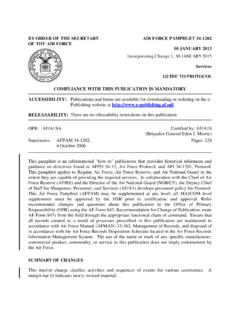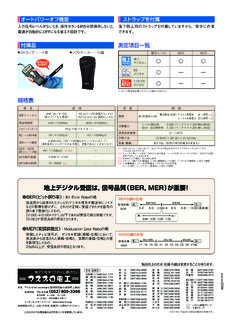Transcription of CHAPTER 3: ITEM-BY-ITEM GUIDE TO THE MDS - CMS
1 CMS s RAI Version Manual CH 3: MDS Items Revised--December 2002 Page 3-1 CHAPTER 3: ITEM-BY-ITEM GUIDE TO THE MDS Overview to the ITEM-BY-ITEM GUIDE to MDS This CHAPTER is to be used in conjunction with Version of the MDS assessment. Also included in this CHAPTER are the instructions for the supplemental items in MDS Sections S, T, and U. Contact your State RAI Coordinator regarding your State s requirements for Sections S, T, and U, as well as for any additional State-mandated MDS assessment requirements. This CHAPTER provides information to facilitate an accurate and uniform resident assessment. ITEM-BY-ITEM instructions focus on: The intent of items included on the MDS.
2 Supplemental definitions, instructions and clarifications for completing MDS items. Reminders of which MDS items require observation of the resident for other than the standard 7-day observation period. Sources of information to be consulted in completing specific MDS items. Using This ChapterUse this CHAPTER alongside the MDS Version data collection form keeping the form in front of you at all times. The amplifying information in this CHAPTER should facilitate successful use of the MDS. The items from the MDS are presented in a sequential basis in this CHAPTER . Where items are presented on a form other than the full MDS assessment form, this fact is noted in the text.
3 The chart that follows summarizes the recommended approach to assist you in becoming familiar with MDS Version The initial time investment in this multi-step review process will have a major payback. CMS s RAI Version Manual CH 3: MDS Items Revised--December 2002 Page 3-2 Recommended Approach for Becoming Familiar with the MDS (A) First, review the MDS form itself. Notice how sections are organized and where information is to be recorded. Work through one section at a time . Examine item definitions and response categories. Complete the MDS assessment for a resident at your facility. Draw only on your knowledge of this individual.
4 Enter the appropriate codes on the MDS. Where your review could benefit from additional information, make note of that fact. Where might you acquire additional information? (B) Complete an initial review of this CHAPTER . Review procedural instructions, time frames, and general coding conventions. Review clarifications, since they provide important information and context in response to questions from other MDS RAI Manual users. Are the definitions and instructions clear? Do they differ from current practice at your facility? What areas require further clarification? As you read this CHAPTER , clarify questions that arose as you used the MDS for the first time to assess a resident.
5 Note sections of this manual that help to clarify coding and procedural questions you may have had. Once again, read the instructions that apply to a single section of the MDS. Make sure you understand this information before going on to another section. Review the test case you completed. Would you still code it the same? It will take time to go through all this material. Do it slowly, carefully, without rushing. Work through the Manual MDS form one section at a time . Are you surprised by any definitions, instructions, or case examples? For example, do you understand how to code ADLs? Or Mood? Would you now complete your initial case differently?
6 Are there definitions or instructions that differ from current practice patterns in your facility? If so, discuss with your MDS coordinator or Director of Nursing to make sure that facility practices comply with the MDS requirements. (continued on next page) CMS s RAI Version Manual CH 3: MDS Items Revised March 2006, December 2005, December 2002 Page 3-3 Recommended Approach for Becoming Familiar with the MDS (continued) Make notations next to any section(s) of this Manual you have questions about. Be prepared to discuss these issues during any formal training program you attend, or contact your State RAI Coordinator (see Appendix B).
7 (C) In a second review of this CHAPTER , focus on issues that seemed to you to be more difficult, problematic, or unfamiliar during the first pass. Make notes on the MDS of issues that warrant attention. (D) The third CHAPTER review may occur during the formal MDS training program at your facility. It will provide you with another opportunity to review the material in this CHAPTER . If you have questions, raise them during the training session. (E) Future use of information in this CHAPTER : Keep this CHAPTER at hand during the assessment process. Where necessary, review the intent of each item in question. This Manual is the primary source of information for completing an assessment.
8 Use it to increase the accuracy of your assessments. Check the MDS web site regularly for updates at: CMS s RAI Version Manual CH 3: MDS Items Revised December 2002 Page 3-4 Standard Format Used in This ChapterTo facilitate completion of Version of the MDS assessment and to ensure consistent interpretation of items, this CHAPTER presents the following types of information for many (but not all) items: Intent: Reason(s) for including the item (or set of items) in the MDS, including discussions of how the information will be used by clinical staff to identify resident problems and develop the plan of care.
9 Definition: Explanation of key terms. Process: Sources of information and methods for determining the correct response for an item. Sources include: Discussion with facility staff - licensed and non-licensed staff members Resident interview and observation Clinical records, facility records, transmittal records (at admission) - physician orders, laboratory data, medication records, treatment sheets, flow sheets ( , vital signs, weights, intake and output), care plans, and any similar documents in the facility record system Discussion with the resident s family Attending physician. Coding: Proper method of recording each response, with explanations of individual response categories.
10 Clarifications: Clarifications for MDS items provided by CMS. These clarifications apply to the MDS. Coding Conventions The coding conventions to be used when preparing the MDS are as follows: CMS s RAI Version Manual CH 3: MDS Items Revised December 2002 Page 3-5 Use a check mark for white boxes with lower case letters in the box or before the item description, if specified condition is met; otherwise these boxes remain blank ( , N4, General Activity Preferences - boxes a. - m.). Use a numeric response (a number or preassigned value) for blank white boxes ( , H1a, Bowel Incontinence.) Darkly shaded areas remain blank; they are on the form to set off boxes visually.















